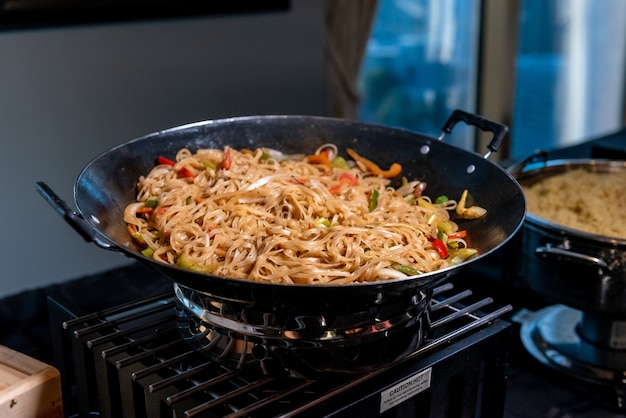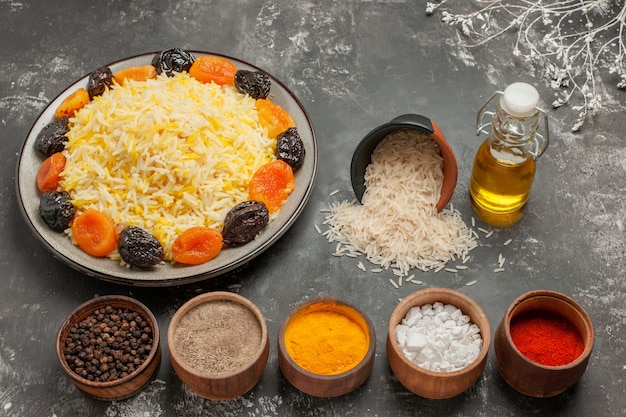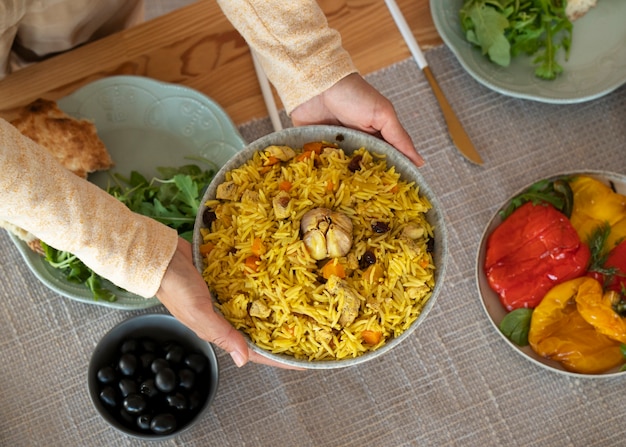Ah, basmati rice. Just the name conjures up images of aromatic, fluffy grains, the perfect accompaniment to a vibrant curry or a hearty stew. For years, I’ve relied on the humble stovetop method to create the perfect pot of basmati rice. It’s a method I’ve refined over time, learning from both successes and the occasional burnt pot, to ensure every grain is cooked to fluffy perfection.
You might be thinking, "perfect rice? That sounds intimidating!" But trust me, it's simpler than you think. It's all about understanding a few key principles and following a straightforward process. This guide isn’t about being a culinary genius, it's about mastering a simple yet essential skill that elevates any meal. You'll be surprised how easy it is to achieve that restaurant-quality rice right in your own kitchen.
So, grab your favourite saucepan, get your spices ready, and let's embark on this delicious journey together.
(Part 1) The Essential Ingredients: A Foundation for Flavour

Before we dive into the cooking process, let’s talk about the building blocks of perfect basmati rice. It all starts with choosing the right ingredients and understanding their role in creating that perfect texture and flavour.
Basmati Rice: The Queen of Grains
When it comes to rice, basmati reigns supreme. It's the quintessential rice for Indian cooking, prized for its long, slender grains, delicate aroma, and its ability to cook up light and fluffy. But not all basmati is created equal. For the best results, look for premium-quality basmati that’s been aged and treated with care. It makes a noticeable difference in both texture and flavour, transforming your rice from good to truly exceptional.
Water: The Unsung Hero of rice cooking
Water might seem like a simple ingredient, but it plays a crucial role in rice cooking. It's the medium that transfers heat, allowing the rice to cook evenly and absorb the flavour of the other ingredients. For the purest flavour, I always use filtered water. It's a little detail, but it makes a difference in the overall taste. If you're using tap water, make sure it's at room temperature, as cold water can affect the cooking time.
Salt: The Secret Weapon for Enhanced Flavour
Salt, that humble seasoning, is a vital component of perfect rice. It doesn't just add flavour, it actually enhances the natural sweetness of the rice and brings out its subtle nuances. I prefer using fine sea salt, but kosher salt works just as well. The key is to add a pinch of salt to the boiling water at the very beginning of the cooking process. This allows the salt to infuse the rice as it cooks, creating a more flavourful and balanced dish.
Optional Extras: A Touch of Luxury and Aroma
While basmati, water, and salt form the foundation, there are a few optional extras that can elevate your rice to a whole new level of flavour and aroma. These are not essential, but they can add a luxurious touch and transform your rice into something truly special.
- Ghee: A dollop of ghee, that rich, clarified butter, adds a luxurious depth of flavour to the rice. It creates a subtle nutty aroma and enhances the overall richness of the dish. However, if you prefer, you can use butter or even olive oil for a lighter flavour.
- Cardamom pods: A couple of green cardamom pods, lightly crushed, add a warm, aromatic touch to the rice. Their subtle sweetness and earthy fragrance complement the delicate flavour of basmati rice perfectly.
- Bay leaf: Adding a single bay leaf to the water infuses the rice with a hint of herbal complexity. It's a subtle flavour, but it creates a more layered and interesting aroma that complements the dish beautifully.
(Part 2) The Secret to Perfect Stovetop Basmati Rice: Unveiling the Magic Formula

Now we get to the heart of the matter: the actual cooking process. It's not complicated, but it's essential to understand the key principles involved. The perfect rice relies on a perfect balance of rice, water, time, and a few little tricks I've picked up over the years.
The Golden Ratio: Finding the Perfect Balance
The most important factor in achieving perfect basmati rice is the ratio of rice to water. This is the magic formula that determines whether your rice will be fluffy and delicious or dry and disappointing. I always use a 1:1.5 ratio, meaning for every cup of rice, I use 1.5 cups of water. This ratio ensures that the rice cooks thoroughly while retaining its fluffy texture, without becoming mushy or dry.
The Cooking Process: A Step-by-Step Guide to Success
Now that we have our ingredients and ratios sorted, let’s get cooking! Here’s my foolproof method, tried and tested countless times, that consistently delivers perfect rice every time.
- Rinse the Rice: The first step is to rinse the rice thoroughly. This removes excess starch, which can make the rice sticky and affect its texture. Gently swirl the rice in a strainer under cold running water until the water runs clear. Be gentle with the rice; you don't want to break the grains.
- Soak the Rice: For even more consistent cooking, I always soak my rice for about 30 minutes before cooking. This helps the rice absorb water evenly, ensuring each grain cooks to perfection. If you're short on time, you can skip this step, but I find that soaking makes a noticeable difference in the final result.
- Bring the Water to a Boil: While the rice is soaking, bring the water to a boil in your saucepan. I recommend using a pot slightly larger than the amount of rice you’re cooking to allow for the rice to expand during the cooking process.
- Add the Salt and Extras: Once the water is boiling, add the salt and any optional extras like ghee, cardamom pods, and bay leaf. This allows the flavours to infuse the water, creating a more aromatic and flavorful rice.
- Add the Rice: Gently pour the rinsed and drained rice into the boiling water, making sure it’s completely submerged. Stir the rice gently to ensure even cooking.
- Bring to a Simmer: Once the rice is added, bring the mixture back to a boil. Then reduce the heat to a low simmer, cover the pot tightly with a lid, and cook for about 15 minutes. The rice should be simmering gently, not boiling vigorously.
- Fluff and Serve: After 15 minutes, turn off the heat and let the rice stand for 5 minutes with the lid on. This allows the rice to steam and absorb any remaining liquid, creating that fluffy texture we’re aiming for. After 5 minutes, use a fork to gently fluff the rice. Don’t stir it aggressively, as this can break the grains. Just move the fork through the rice a few times, separating the grains and creating a light, airy texture.
(Part 3) The Art of Fluffing: Unlocking the Perfect Texture

Fluffing the rice is a crucial step that often gets overlooked, but it's essential for achieving that light and fluffy texture. Think of it as a final touch that separates good rice from truly exceptional rice.
After the rice has steamed for 5 minutes, gently lift the lid and use a fork to gently fluff the rice. Don’t stir it violently, as this can break the grains. Just move the fork through the rice a few times, separating the grains and creating a light, airy texture. This simple step will make all the difference in the final result, ensuring your rice is perfectly fluffy and delicious.
(Part 4) Tips and Tricks for Stovetop Success: Mastering the Art of Rice Cooking
Over the years, I’ve learned a few tips and tricks that consistently help me achieve perfect rice. These are little details that might seem insignificant, but they can make a big difference in the final result.
Don’t Overcook: The Key to Fluffy Perfection
One of the biggest mistakes people make when cooking rice is overcooking it. This leads to mushy, sticky rice, which is not the fluffy texture we're aiming for. So, stick to the 15 minutes cooking time and you’ll be rewarded with perfectly fluffy rice.
Use a Tight-Fitting Lid: Trapping the Steam for Even Cooking
A tight-fitting lid is essential for trapping the steam and ensuring the rice cooks evenly. If you have a lid that doesn't fit perfectly, you can try placing a tea towel between the lid and the pot to create a better seal. This helps to prevent steam from escaping and ensures the rice cooks evenly throughout.
Don’t Peek: Trust the Process for Perfect Results
I know it's tempting to lift the lid and check on the rice while it’s cooking, but resist the urge! Opening the pot will release steam and disrupt the cooking process, which can lead to unevenly cooked rice. Trust the process and leave the lid on for the full 15 minutes. The rice will be perfect if you just leave it alone.
(Part 5) Serving Suggestions: A World of Flavour Awaits
So, your perfect basmati rice is ready. Now comes the fun part: serving it up with your favourite dishes. The possibilities are endless, from classic Indian curries to Middle Eastern delights and simple sides.
Indian Classics: A Perfect Match of Flavours
For me, nothing beats basmati rice with a classic Indian curry. The fragrant rice perfectly complements the rich, flavorful sauces, creating a symphony of taste. Think butter chicken, saag paneer, vindaloo, or even a simple lentil curry. The combination is truly divine.
Middle Eastern Delights: A Journey of Textures and Flavours
Basmati rice is also perfect for Middle Eastern dishes. Pair it with a hearty lamb stew, a fragrant tagine, or a refreshing salad with lemon and herbs. The light and fluffy texture of the rice provides a perfect contrast to the bold flavours and textures of Middle Eastern cuisine.
Simple Sides: Elevating Everyday Meals
And don’t forget about the simple sides. Basmati rice makes a wonderful accompaniment to roasted vegetables, grilled chicken or fish, or even a simple salad. It adds a touch of elegance and sophistication to any meal, making it feel special, even when it’s a simple weeknight dinner.
Beyond the Plate: Unlocking a World of Culinary Creativity
Don’t stop there! Get creative and use your perfect basmati rice in a variety of dishes. Think rice bowls, stir-fries, salads, or even as a base for your favourite sushi. The possibilities are endless. The versatility of basmati rice allows you to experiment and create dishes that are both delicious and visually appealing.
(Part 6) Storing Leftovers: Making the Most of Your Rice
Let's be honest, sometimes we end up with leftover rice. And it's not a bad thing at all! Leftover basmati rice is perfect for quick and easy meals, like rice salads or fried rice. Here's how to store and reheat it properly to ensure it stays fresh and flavorful.
Refrigerate Properly: Preserving the Flavour
To store leftovers, let the rice cool completely and then transfer it to an airtight container. Refrigerate for up to 3 days. This prevents the rice from drying out and helps maintain its flavour and texture.
Reheat Carefully: Restoring the Perfect Texture
When you're ready to reheat your leftover rice, I recommend using the microwave or a saucepan on the stovetop. Add a little water or broth to prevent the rice from drying out. And always make sure the rice is heated through before serving. A few minutes in the microwave or on the stovetop will restore the rice to its original fluffy texture, making it perfect for a quick and delicious meal.
(Part 7) Troubleshooting: Addressing Common Rice-Cooking Challenges
Even the most experienced cooks can run into trouble sometimes, especially when it comes to rice cooking. But fear not! Here are a few common challenges and how to address them:
Rice is Too Mushy: Finding the Right Water Ratio
If your rice is too mushy, it's likely you used too much water or cooked it for too long. Next time, try using less water (maybe 1.25 cups per cup of rice instead of 1.5) and keeping a closer eye on the cooking time. You can also try a different type of rice, as some varieties require more water than others.
Rice is Too Dry: Ensuring Enough Moisture
If your rice is too dry, you probably didn't use enough water. Try adding a little more water next time. You can also experiment with different types of rice, as some varieties require more water than others. For example, long-grain rice usually requires more water and longer cooking time than basmati rice.
Rice is Clumpy: Preventing Sticking
If your rice is clumpy, you might not have rinsed it properly. Make sure to rinse the rice thoroughly until the water runs clear. You can also try using a different pot or pan, as some pots are more prone to sticking than others. Using a non-stick saucepan can help prevent sticking and ensure even cooking.
Rice has a Strange Smell: Choosing Fresh and Properly Stored rice
If your rice has a strange smell, it's likely that the rice is old or has been stored improperly. Always check the expiration date on your rice and make sure to store it in an airtight container in a cool, dry place. This will help preserve the flavour and freshness of the rice, ensuring it's free from any unwanted odours.
(Part 8) FAQs: Clearing Up Common Queries
Here are some frequently asked questions about cooking perfect basmati rice.
Can I use different types of rice?
While basmati rice is my personal favourite, you can definitely use other types of rice. Just remember that different types of rice have different cooking times and water ratios. For example, long-grain rice usually requires more water and longer cooking time than basmati rice. If you're using a different type of rice, adjust the cooking time and water ratio accordingly.
Can I use a rice cooker?
Absolutely! Rice cookers are a great way to cook rice, and they often have specific settings for different types of rice. However, if you're looking for the classic stovetop experience, I encourage you to try this method. It allows you to control the cooking process and create perfectly cooked rice every time.
What if I don’t have ghee?
No worries! You can use butter, olive oil, or even just a little bit of water. The important thing is to add something to the water to help the rice cook evenly and prevent sticking. Butter and olive oil will add a bit of flavour, while water will create a more neutral base.
What are some other spices I can add?
Cardamom pods and bay leaves are my go-to spices, but you can experiment with others, too. Try adding cumin seeds, coriander seeds, cloves, or even a pinch of turmeric for a brighter flavour. Just be careful not to overdo it, as you want the flavour of the rice to shine through.
Can I cook the rice ahead of time?
Yes, you can cook the rice ahead of time and reheat it later. Just let the rice cool completely before storing it in an airtight container in the refrigerator. To reheat, add a little water or broth to the rice and microwave or heat it on the stovetop until warmed through. This is a great way to save time and have a delicious meal ready to go.
There you have it! My complete guide to perfect stovetop basmati rice. Now go out there and wow your friends and family with this simple, flavourful dish. And remember, cooking is all about experimenting and finding what works best for you. So have fun and enjoy the journey!
Everyone is watching

Corn on the Cob: The Ultimate Guide to Perfectly Cooked Ears
Healthy MealsAh, corn on the cob. Just the name evokes images of sunny days, barbecues, and that sweet, juicy flavour that ...

Perfect Pork Roast Oven Cooking Time: A Guide to Delicious Results
Healthy MealsThere's something truly satisfying about a perfectly roasted pork. The aroma alone is enough to make your mout...

Ham Cooking Time: How Long to Bake, Smoke, or Boil a Delicious Ham
Healthy MealsAh, ham. It's a classic, isn't it? A real crowd-pleaser, especially around holidays. And when done right, it'...

Scallops: The Ultimate Guide to Perfect Cooking
Healthy MealsAh, scallops. Those delicate, sweet, and utterly delicious morsels of the sea. They hold a special place in my...

Spaghetti Squash: The Ultimate Guide to Cooking and Serving
Healthy MealsRemember that time you saw spaghetti squash at the supermarket, looking all bumpy and strange, and thought, "W...
